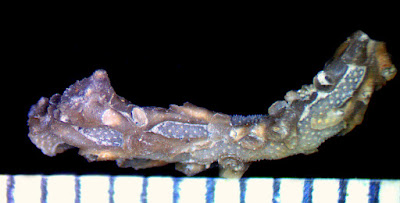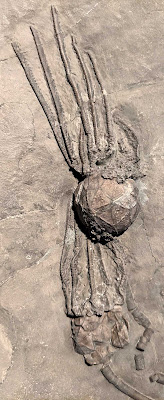The image shows an Anthonomus defossus (Scudder, 1876) snout nosed beetle insect fossil found in the Florissant Formation of Teller County, Colorado, USA. It dates to the Chadronian Stage (37.2 - 33.9 million years ago) of the Eocene Epoch of the Paleogene Period. Thanks to Doug for the image. Field of view (FOV) is 2 mm.
Sunday, December 26, 2021
Saturday, December 25, 2021
Lacewing Insect Fossil
The image shows a lacewing insect fossil found in the Florissant Formation of Teller County, Colorado, USA. It dates to the Eocene Epoch of the Paleogene Period. Thanks to Doug for the image. Field of view (FOV) is 6 mm.
Merry Christmas everybody!
Tuesday, December 21, 2021
Trading Places in a Devonian Sea
My cousin Kenny sent me some pictures of some fossils he screened from micro material I brought back from Alpena Michigan USA. What I found interesting was two specimens show the interactions between bryozoan and coral fossils. One specimen shows a coral growing on a bryozoan and another shows the reverse. First picture shows an Aulopora (Goldfuss, 1829) coral growing on what appears to be a Fistulipora (McCoy, 1849) bryozoan. The next image shows an Aulocystis ramosa with a matting Fistulipora bryozoan growing on top of it.
The next image shows the same type of coral fossil with a matting bryozoan. Field of view (FOV) in these images is about 12-15 mm.
Sunday, December 19, 2021
Strophondonta crassa Brachiopod Fossil
Thanks to Kenny for image and screen material to find fossil.
Thursday, December 9, 2021
Marrella splendens Arthropod Image
This image created by Doctor Elvira Wood and published in 1920 in The Appendages, Anatomy, and Relationships of Trilobites by Percy E. Raymond. It is of a Marrella splendens (Walcott, 1912) arthropod. Charles Doolittle Walcott collected it from the Burgess Shale of British Columbia, Canada in 1909. He described it as a "lace crab". It turns out it is not a trilobite or a crab. The creature lived in the Cambrian Period.
This image is not correct as you will see if go to the Wikipedia entry below to see more modern interpretations of what this animal looked like. Dr. Raymond was directing Dr. Wood how to illustrate this fossil. He writes on page 116, "The accompanying restoration of the ventral surface of Marrella is a tentative one, based on Doctor Walcott's description and figures. ... The restoration is therefore subject to revision as the species becomes better known."
Learn more at: https://en.wikipedia.org/wiki/Marrella
Sunday, December 5, 2021
Hexagonaria Coral with Hederella Bryozoan Fossils
These pictures are of a Hexagonaria anna (Whitfield, 1973) coral fossil. It was found in the Bell Shale of the Traverse Group of Alpena, Michigan, USA. The coral lived in the Devonian Period. On the bottom of the coral is a small colony (3 cm long) of Hederella (Hall, 1883) bryozoans.
Sunday, November 28, 2021
Michigan Black Atrypa Brachiopod
Sunday, November 21, 2021
Louisville Soccer and Living Fossils
On Saturday, November 20, 2021 Louisville Kentucky USA hosted the National Women's Soccer League (NWSL) championship game which turned out into a competitive match between Chicago Red Stars and the Washington Spirit. The Washington Spirit team ending up winning 2-1 and the above picture shows their award ceremony.
10,360 showed up for the game and as a result I went to the game several hours early and stayed about 90 minutes after it ended because of traffic. In this extra time, I explored around the stadium and found that the trees planted around the perimeter were Ginkgo biloba (Linnaeus, 1771). According to Wikipedia, while the species was named by Swedish botanist Carl Linnaeus, Chinese herbalists named it in literature as early as 1329. The fossil record shows leaves from the Permian Period (about 290 million years ago). I have posted about this fossil before back in 2010 (LINK).
I am curious as to why this tree was chosen for the landscaping the complex. As it turns out, I help the landscape architect from time to time with IT issues. Next time, I encounter him I plan to ask about this. If you get a chance, I encourage you to attend a Racing Louisville or Louisville City soccer game at Lynn Family stadium and check these trees out for yourself and the beautiful venue.
Sunday, November 7, 2021
Caryocrinites ornatus Cystoid Fossils
My September 2021 trip to Alpena, Michigan USA included a visit to local paleontologist Paleo Joe (aka Joseph Kchodl).
This picture is of one of his cystoid fossils from Middleport, New York USA. This fossil is known as Caryocrinites ornatus (Say, 1825). It was found in the Rochester Shale and existed in the Silurian Period.
Another beautiful specimen fossil of this species can be found at this web site http://www.primitiveworlds.com/cystoids-3.html
The next picture shows the same cystoids buy you can see their almost full length stems down to the holdfast. Also a Striispirifer niagarensis (Conrad, 1843) brachiopod fossil on that matrix as well.
Saturday, November 6, 2021
Icthyocrinus laevis Crinoid Calyx Fossil
My September 2021 trip to Alpena, Michigan USA included a visit to local paleontologist Paleo Joe (aka Joseph Kchodl).
This picture is of one of his crinoid calyx fossils from Middleport, New York USA. This fossil is known as Icthyocrinus laevis (Conrad, 1842). It was found in the Rochester Shale and existed in the Silurian Period.
Another beautiful specimen fossil of this species can be found at this web site http://www.primitiveworlds.com/crinoids-14.html
Sunday, October 24, 2021
Hexagonaria Coral Fossil
Sunday, October 17, 2021
Heliophyllum? Coral Fossil from Michigan
These pictures of what looks like a Heliophyllum sp. (Hall, 1846) coral fossil plus there are some bryozoan colonies. It was found in the Bell Shale of the Traverse Group of Rogers City, Michigan, USA. The coral lived in the Devonian Period.
Saturday, October 16, 2021
Atrypa Brachiopod Fossil from Michigan
These pictures are of an Atrypa sp. (Hall, 1862) brachiopod fossil. It was found in the Genshaw Formation at Carmeuse Quarry of Rogers City, Michigan, USA. The brachiopod lived in the Devonian Period (Givetian age). In September 2011, Dave wrote about another brachiopod from this area which is called "Blue Beds". The fossil has a blackish-brown color. Dave speculated that it might caused by hydrocarbons (bitumen, tar, or oil). See his post at Views of the Mahantango blog here.
Thursday, October 14, 2021
Hexagonaria anna Coral Fossil
These pictures of a Hexagonaria anna (Whitfield, 1973) coral fossil. It was found in the Bell Shale of the Traverse Group of Alpena, Michigan, USA. The coral lived in the Devonian Period.
On the bottom of the fossil are a number Aulopora coral fossils that grew on the Hexagonaria. Also there are a number of bryozoan colonies. Plus there is a Aulopora coral fossil found on the top of the coral.
Saturday, October 9, 2021
Native American Bird Stone From Hexagonaria Fossil
The Besser Museum for Northwest Michigan was named for Jesse Besser (1882-1970) who perfected and produced machines that create these famous concrete blocks. Out in the yard is a huge boulder sized Hexagonaria (Gürich, 1896) coral fossil (from Devonian Period). They also have areas where you can search for and keep fossils from material dumped there from local quarry.
Wednesday, October 6, 2021
Bryozoan Holdfast Fossil
Monday, October 4, 2021
Atrypa Brachiopod Fossil with Crystallized Lophophore
Check out this picture of an Atrypa (Hall, 1862) brachiopod fossil (note the two elliptical shapes which are feeding tubes or lophophore that have crystallized). The fossil was found in the Genshaw Formation at Alpena, Michigan USA. The creature lived Middle Devonian Period (Erian Stage).
Sunday, October 3, 2021
Anthonomus defossus? Snout Beetle Fossil
Friday, October 1, 2021
Dicranurus hamatus Trilobite Fossil
On a recent trip to Alpena, Michigan USA with several amateur paleontologists from Louisville and one from Chicago, we visited a local paleontologist Paleo Joe (aka Joseph Kchodl). This picture is of one of his trilobite fossils from Oklahoma. This fossil is known as Dicranurus hamatus (Conrad, 1841). It was found in the Haragan Formation and existed in the Devonian Period.
Learn more about Oklahoma trilobites in the Geological Survey Bulletin 123 Trilobites of the Haragan, Bois D'Arc and Frisco Formations (Early Devonian) Arbuckle Mountains Region, Oklahoma by K. S. W. Campbell (1977). Paper can be found at this LINK.Thursday, September 30, 2021
Proaster Brittle Star Fossil
My September 2021 trip to Alpena, Michigan USA included a visit to local paleontologist Paleo Joe (aka Joseph Kchodl).
This picture is of one of his brittle star fossils from Middleport, New York USA. This fossil is known as Protaster sp. (Forbes, 1849). It was found in the Rochester Shale and existed in the Silurian Period.
Genus was named by Edward Forbes (1815-1854) in Figures and descriptions illustrative of British Organic Remains. Memoirs of the Geological Survey of the United Kingdom (1849).
Wednesday, September 29, 2021
Chilotrypa ostiolata Bryozoan Fossil
My September 2021 trip to Alpena, Michigan USA with several amateur paleontologists from Louisville and Chicago, we visited a local paleontologist Paleo Joe (aka Joseph Kchodl).
This picture is of one of his bryozoan fossils from Middleport, New York USA. This fossil is known as Chilotrypa ostiolata (Hall, 1852). It was found in the Rochester Shale and existed in the Silurian Period.
Tuesday, September 28, 2021
Aulopora conferta Coral Fossil
This fossil is really nice with Aulopora conferta? (Winchell) coral growing on what might be Hexagonaria.(Gürich, 1896). It was found in the Bell Shale of the Traverse Group at Carmeuse Quarry, Rogers City, Michigan, USA. The fossil dates to the middle Devonian Period (Givetian Stage).





















































